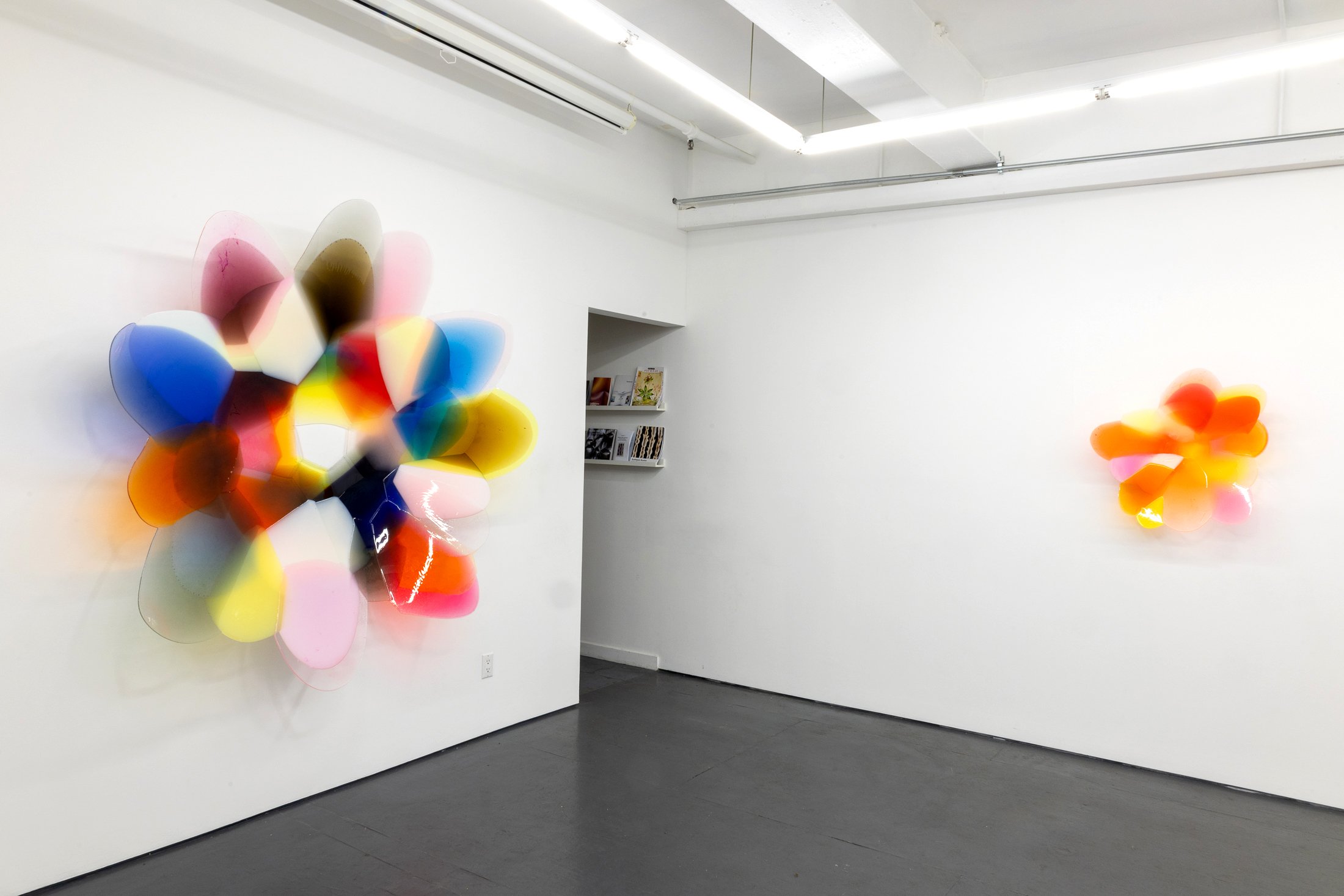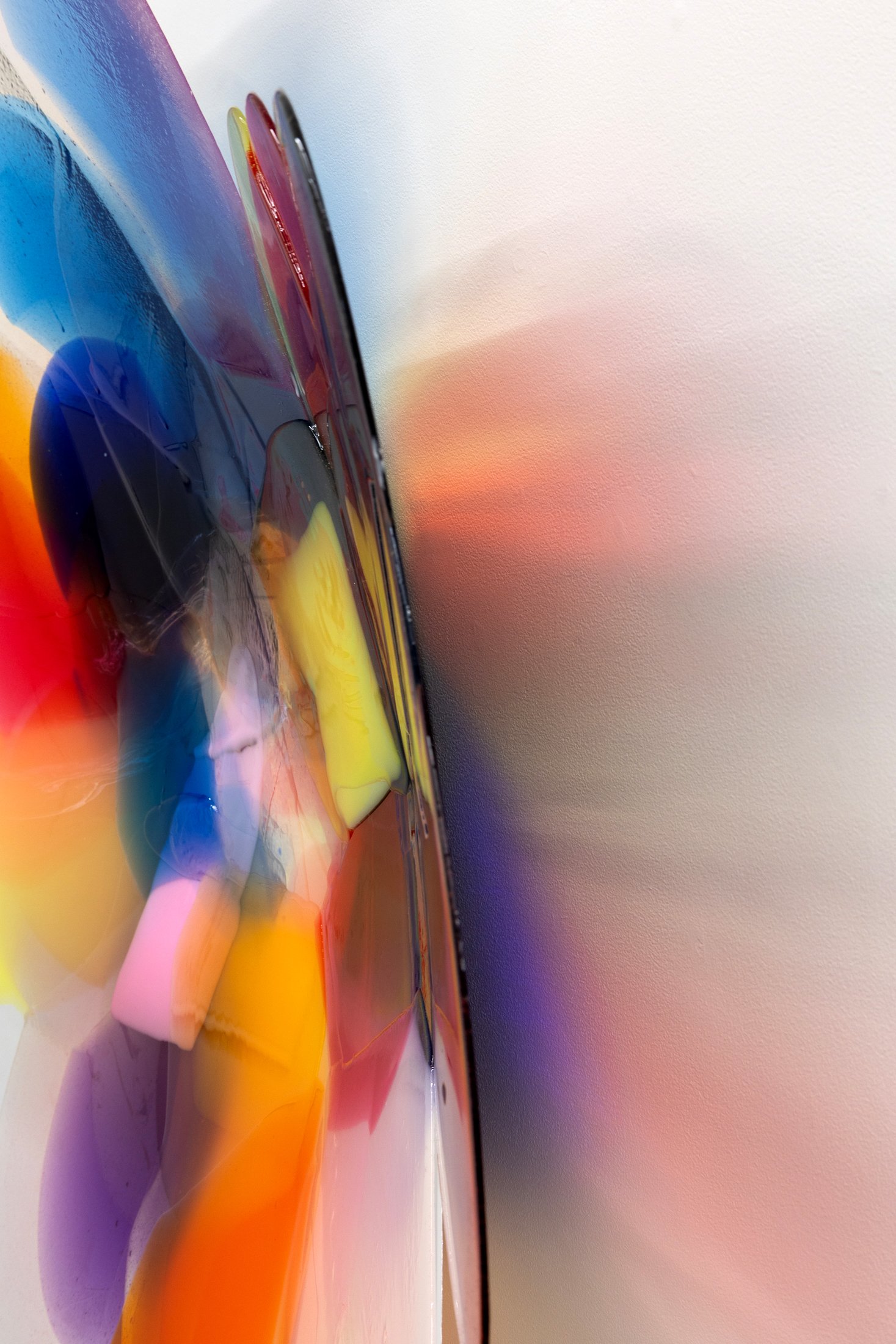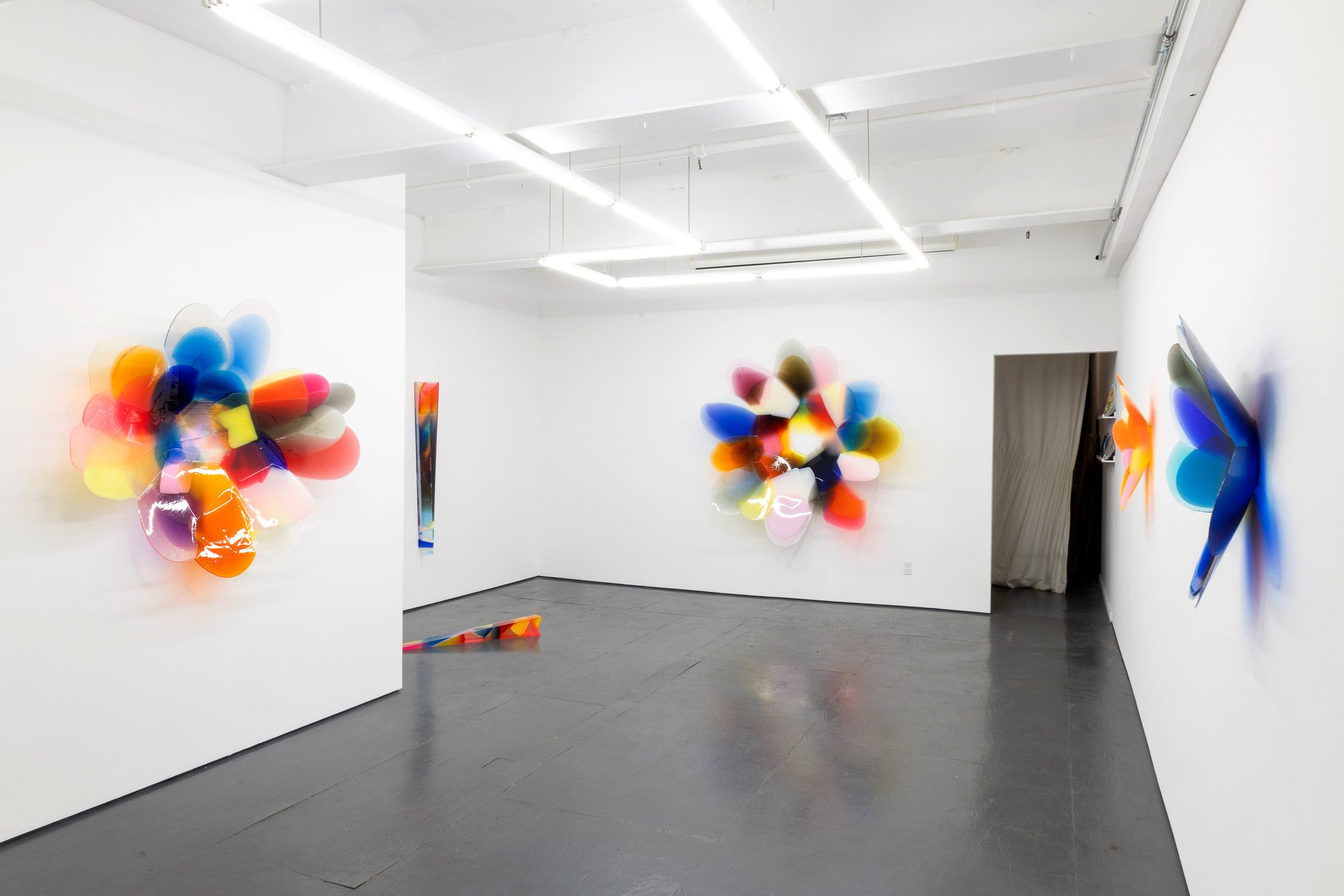Something Just Happened
Recent Works by Ben Godward
JUNE 24 - JULY 30, 2023
Opening Reception Saturday, June 24, 5-8 PM
Transmitter is pleased to present Something Just Happened, a solo presentation of recent works by Brooklyn based artist Ben Godward.
Godward’s process of utilizing poured colored resins in, over, and onto objects, molds and shapes, challenges our expectations of movement and time by arresting fluid liquids and materials into a state of stasis.
Godward’s earlier work seemed to use colored expandable foam to encapsulate his Bushwick surroundings and all of its growing exuberance. Objects were enveloped like a contemporary version of Cretaceous insects in amber. The more recent pieces showcased in Something Just Happened appear purposely directional. Wedges that point, and concave shapes that project from the wall ubiquitously penetrate the viewer’s space. Gravity, exploited during the many pours involved in the process, results in works that seem as if the rules of gravity have ceased, like a suspended explosion.
Transmitter asked Godward some questions regarding his work and practice:
Transmitter: How did you end up in Bushwick, and did this connection to the neighborhood influence your work in a particular direction?
Ben Godward: Like a generation of artists I ended up in debt after grad school and in need of a softish landing spot. The Loft on Melrose was the ticket. A friend of a friend (Kevin Curran) was teaching in Japan so I slept on a plywood floor under a big fan. It was terrible and I loved it. I lived there for over a decade. I met an amazing amount of cool people at Pocket Utopia and Famous Accountants and English Kills. I don’t think there was an aesthetic of Bushwick or anything, we all just kept making work. It had a DIY flavor, but just out of necessity we were building it. I am fully a product of it now. But likewise I think “Bushwick” is a product of all that energy that everyone has put in.
NYC in a larger sense has exposed me to painting in a way that I didn’t anticipate. It’s a painting town and I love it. I don’t think you can start seeing any medium really accurately without seeing a ton of it. I guess it’s osmosis. But it seeped in.
To say that things have changed since I moved here 15 years ago seems unnecessary, it’s different now, but still an incredibly dynamic place with a crazy concentration of creative production.
T: There are painterly sculptors and ‘sculptorly’ painters. How do you as a sculptor see your relationship to the second dimension?
BG: I’m an Artist first, but there is something about sculpture. It forces you to confront an object in real life. You can look at sculpture on your phone but it really won’t do the thing. It needs to be experienced. I was flirting with painting for a while. I made a bunch of rectangular pieces and set them on shelves on the wall. There wasn’t canvas but…I think they were successful and I needed to get that far to understand that I’m not a painter. Painting doesn’t own color. I needed to go back into my practice and choose forms that would allow me to articulate space and to use the potential I saw with the resin. The choosing of forms was not something I was really versed in so I had to really break down why I was pouring things, what the motivation for the accumulation was, and I ended up back in the Bronze Age with standing stones of Carnac. They are located in north-western France, they felt true in a way that the best art does. They were compelled to make a compelling thing.
T: Where do you see your work in relation to the West Coast “Light and Space” movement, of which Dewain Valentine and John McCracken were big proponents?
BG: Light and space can mean a lot of different things. McCracken was really into the form of it. For Turell it’s about light and phenomena. Irwin would tell you it’s about perception of space and light and everything. Irwin made one of the most important art films for me - “the beauty of questions” (finally available online via Perrotin on YouTube) - and his attitude in that film is mesmerizing. But my complaint with the majority of the light and space movement is the machine quality of it all. It feels too concerned about the Platonic ideal. The hand gets lost which is probably one of the reasons I relate to painting. Paintings show time and gesture and labor. I’m not that interested in perfection. Never really have been. I’m much more into the wonder of it all despite wallowing in the mire.
T: You mentioned that the concave wall pieces you are currently working on are shaped to convey, or transmit, like radios. Could you elaborate on this?
BG: Not exactly, I think of them as projecting. They push out into physical space. They have an interior and exterior. The interior is open to the viewer. I think of them as explosions or projecting energy outward. I’ve titled some of them after lyrics that aren’t words. I think of them as a primal bit of energy or poetry that is hard to define but unmistakable. They are points for departure. Breath turned to music. Music recorded becoming an icon not to the individual but to a time. Projecting energy away is also the opposite of the “wedges" which consolidate and concentrate energy. Where the “wedges” are dangerous and fragile the “projections” are open, vulnerable and grand.
T: Your choice of materials – resins, foams – have an artificial quality to them that in combination with some of your color choices could be seen as reactionary or a rejection of traditional means and methods. Am I reading too much into this?
BG: No, you are correct. I used to make bronze and steel sculptures. While successful in some ways, they seemed of another time. My lived experience is not one of gently patinated bronze but vibrantly colored plastics. Also the process of only adding material is intentional. We are not a refined, polished society. Every decision is an addition, there is no erasure. Bad decisions are lived with and reacted to, rarely do they lead to full disaster, but rather become something new to react to. An internal tension develops.
T: There are colorful transparencies and opacities in your work playfully casting light and shadow on their surrounding surfaces making the work expand beyond their physical presence. Do you see this casting as secondary or do you allow this to happen in a specific way?
BG: Secondary, but it is part of their energy. I try to embrace it but not be overly dogmatic in how it happens. I love drama in the reflections and refractions. I’m making objects not immersive theme parks. My hope is that these go out in the world. They change a space and are changed by their surroundings. New possibilities are thus continually discovered.
About the Artist:
Ben Godward’s works have been shown at Norte Maar, Rick Wester Fine Art, Slag Gallery, Socrates Sculpture Park, The Brooklyn Museum, Scully-Tomasko Foundation, Marc Straus Gallery, among others, and his work has been reviewed by The New Criterion, Two Coats of Paint, The L-Magazine, Hyperallergic and The Brooklyn Rail. He lives and works in Brooklyn.









